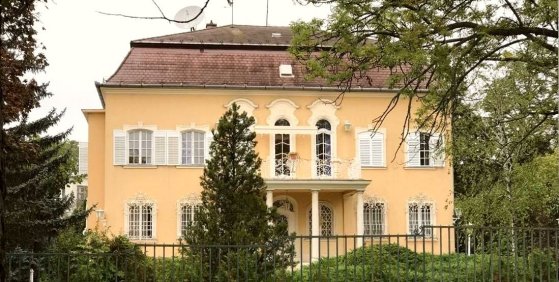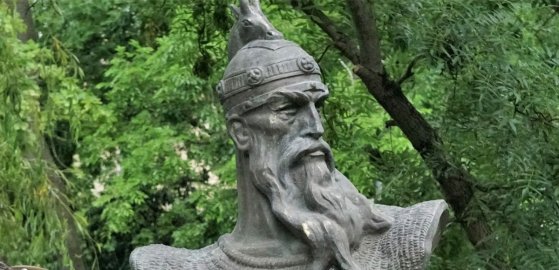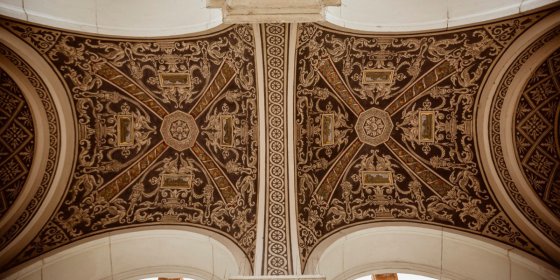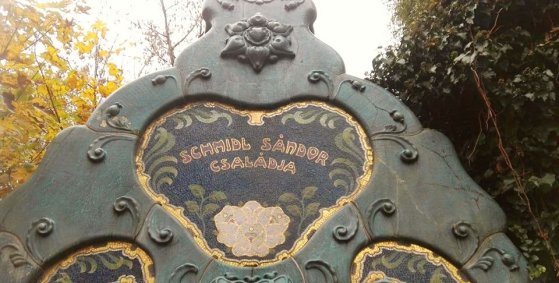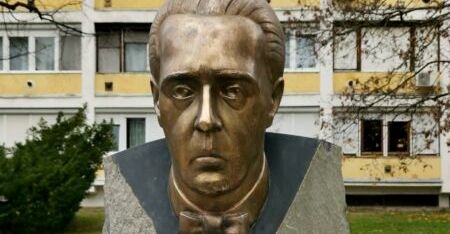 The „intertwined history” of the bridges and the city of Budapest
Which ideas and events have shaped the fate of bridges of Budapest and the cityscape? Alongside many other interesting facts, this question is also answered this newly published book by the Budapest City Archives, which introduces the history of bridges in Budapest.
The „intertwined history” of the bridges and the city of Budapest
Which ideas and events have shaped the fate of bridges of Budapest and the cityscape? Alongside many other interesting facts, this question is also answered this newly published book by the Budapest City Archives, which introduces the history of bridges in Budapest.
Art
 The statue of the writer Ferenc Herczeg was inaugurated
The statue of the writer Ferenc Herczeg was inaugurated
September 21, 2021 at 6:00 PM
A bust of Ferenc Herczeg, the most popular writer of the period between the two world wars, who was the first Hungarian writer to be nominated for the Nobel Prize for Literature, was erected in the building of the National Theater. He was exiled from Hungarian literature after the Second World War, and his works were republished only after the change of regime. The work of sculptor Mária Törley now commemorates Ferenc Herczeg.
Across Budapest we can see the statues of Pál Pátzay, born 125 years ago
September 20, 2021 at 9:00 AM
The round anniversary provides an opportunity to take an objective approach to the artist, who was imprisoned after the Hungarian Soviet Republic and then joined the Roman school in the 1930s and became more widely known through his sculptures of party leaders in the decades of socialism. His sculptures can be found in several places all over the city: with Bálint Balassi on the Kodály Körönd, with the female figure defying the wind on the Danube Promenade, or with the Raoul Wallenberg monument in St. Stephen's Park.
András Mayerhoffer, the creator of the Hungarian Baroque style, died 250 years ago
September 12, 2021 at 9:30 AM
András Mayerhoffer, born in Salzburg, is one of the leading figures of Baroque-Rococo architecture in Hungary. He is also known as the creator of the so-called Grassalkovich or Gödöllő style. The works of the master builder and architect, who died 250 years ago, such as the first two-towered Catholic Church in Pest or the former Péterffy Palace in Piarista Street - are still defining elements of Budapest's cityscape.
There was no place for it in the St. Stephen's Park - the statue of our founding king was erected in Kispest
August 19, 2021 at 6:30 PM
The work was originally intended to replace the statue of György Lukács in Szent István Park, but the Capital decided otherwise, so the 2.5-metre-high bronze statue of our founding king ended up not in the park named after him, but in the Templom Square of the 19th District.
The reborn St. Stephen's Hall of the Buda Castle was solemnly handed over
August 18, 2021 at 1:30 PM
The St. Stephen's Hall of the Buda Palace, which was once one of the most ornate rooms in the palace, was renovated with complete historical fidelity. The room, rebuilt in its original form, will be open to the public free of charge from 20 August until the end of the month, following today's official handover.
The world-famous chandeliers of the Kissling Factory - The former ornate luminaires were re-created for St. Stephen's Hall
August 12, 2021 at 11:00 AM
Among the outstanding applied arts companies of the age of dualism, Rudolf Kissling and his son played a significant role with their chandelier and bronze cast factory. Thanks to their artistic work, many of the public buildings built in this era were decorated with their chandeliers and other bronze objects. The original chandeliers of the St. Stephen's Hall in Buda Castle were also made by the Kissling Factory, and the works of applied art were re-created after a long research work.
For the first time, we can see in photos what the reborn St. Stephen's Hall looks like
August 6, 2021 at 12:00 PM
For the first time, we can see in photos what the new St. Stephen's Hall in the Buda Castle looks like, which will be opened to the public on 20 August, in two weeks. In the newly taken photographs, we can see several details of the historic ceremonial hall, including the new Zsolnay fireplace, new floor and wall coverings, new pyrogranite images of kings and Hungarian saints, and even a close-up of an armchair and a curtain upholstery.
The first lion statue was taken off the Chain Bridge
August 5, 2021 at 2:00 PM
During the renovation of the Chain Bridge, the removal of the stone lions at the Pest bridgehead was started. The three-piece sculptures will be removed and restored, with plans to return them to their place at the end of next year. During the renovation, only those parts of the works that originally existed are restored.
Árpád Göncz and his wife will receive a statue in Vérhalom Square
July 21, 2021 at 4:00 PM
A tender was announced for the creation of a double statue of the former President of the Republic and his wife, which will be located in Vérhalom Square in the 2nd District, near the last home of the Göncz couple.
A statue was erected for Skanderbeg, an ally of János Hunyadi, in the Városliget
July 5, 2021 at 4:00 PM
The bust of Skanderbeg was inaugurated in the neighborhood of Vajdahunyadvár, on the Platán promenade in the Városliget. The work is a gift from the city of Tirana to Budapest. Albanian prince Skanderbeg once fought in alliance with János Hunyadi against the expansion of the Ottoman Empire.
From the Opera House to the Parliament - The decorative painting of several representative buildings is the work of Róbert Scholtz
July 5, 2021 at 9:30 AM
Ornate public buildings and palaces were defining parts of the cityscape of Pest-Buda, which became a more and more civilized city and a metropolis. Róbert Scholtz, a decorative painter, played an important role in decorating many representative buildings, and his work is famous for, among other things, the St. Stephen's Hall, which was destroyed in 1945, but will soon be rebuilt.
Glass mosaic by Miksa Róth restored above the entrance of the Lutheran church on Fasor
June 21, 2021 at 4:30 PM
Miksa Róth's glass mosaic was placed above the entrance of the Lutheran church in Fasor. The work from 1905 has been returned after more than a year of restoration.
The first statue of Saint Stephen in Budapest was completed in 1906
May 25, 2021 at 10:00 AM
The statue of Saint Stephen has been standing in Buda Castle next to the Fisherman's Bastion for 115 years. Although the founding king of Hungary has always been highly respected in the country, the great work of Alajos Strobl was completed slowly. The first statue of King Stephen in Budapest was inaugurated in 1906 next to Matthias Church almost 40 years after it was first planned.
The cult of Saint Emeric of Hungary – The 18th District stands in memory of the Prince
April 14, 2021 at 10:30 AM
Hungary celebrated the life of Saint Emeric, the son of the country's first King, Saint Stephen, 90 years ago. On the 900th anniversary of the death of Prince Emeric (Imre), who was consecrated together with his father in 1083, a large-scale memorial year was organized in 1930–1931 and the village of Pestszentimre was named after him, which in 1950 became part of the 18th District of Budapest. The church in the district also bears the name of the prince, and the first public statue of the district also depicts Saint Emeric.
Depictions of Christ portray the events of the Holy Week around Budapest
April 4, 2021 at 9:30 AM
Depictions of Jesus can be found in every district of Budapest of one walks with their eyes open. Most often, crosses erected near Catholic churches or by public roads are reminders of Christ’s crucifixion, but several Calvaries, statues, and building mosaics also depict Easter-related events: the story of the Passion and the resurrection of the Messiah. This virtual walk will present a selection of the most valuable works of art that give hope at Easter in 2021.
A master of beautiful gates – Works by Gyula Jungfer adorn public buildings around Budapest
January 20, 2021 at 10:00 AM
A walk around the representative public buildings of Budapest is almost a walk to visit the major works on GyulaJungfer. The artist that reimagined ironworking in Hungary and elevated it to an applied art was born 180 years ago. His work still defines Budapest.
Franz Joseph supported exhibition to showcase the most famous Hungarians
January 15, 2021 at 11:00 AM
A long-awaited exhibition opened in the Castle Garden Bazaar 135 years ago. Entitled Portrait Gallery of Hungarian History it collected depictions of the most famous Hungarians in chronological order. The effort was supported from the highest levels, and its creation was seen as not only a cultural but academic endeavour.
Churches of the Holy Family call the faithful in both Buda and Pest
January 13, 2021 at 1:00 PM
On 27 December last year, Pope Francis announced in Rome that the Catholic Church will celebrate a special year dedicated to family love, beginning on 19 March 2021. Discussions about the concept of a family have recently brought the issue to the front of public debates, making the Year "Amoris Laetitia Family" a particularly well-timed initiative in the country. Currently, three churches in Budapest are dedicated to the Holy Family, reminding the faithful that family appeared as a fundamental value and a natural element of human existence at the beginning of Christianity. In preparation for the year of the family, Pestbuda visited the Churches of the Holy Family in Zugliget and Terézváros.
Tradition and Modernity: The sacred art of Béla Lajta
November 26, 2020 at 10:00 AM
In a recent article, PestBuda honoured the memory of Béla Lajta. One of the leading Hungarian architects of the early 20th century, Lajta played a definitive role in the formation of Budapest in the period. Continuing a series in honour of the centenary of his death, join us on a tour of his sacred art in the Jewish cemeteries of Salgótarjáni Street and Kozma Street.
Márai statue unveiled in Újpest
November 19, 2020 at 9:00 AM
The new bronze bust of the writer Sándor Márai was erected in the suburbs of Újpest on Szent László Square.
Original ornaments returned to Bull Statue in Újbuda
November 5, 2020 at 5:00 PM
The statue entitled Monda ('myth') in Bikás ('bull') Park has been restored. The original ornaments symbolising the Sun, Moon and Starts above the heads of the bulls have been replaced.
Legends from Buda Castle: Descendants of Hauszmann and Strobl join opening of new photographic exhibition in the Castle Garden Bazaar
September 25, 2020 at 12:00 PM
The descendants of the Alajos Hauszmann, the Teleki family and Alajos Strobl can be seen in the portraits newly on display on the Southern Panorama Terrace of the Castle Garden Bazaar. The exhibition entitled legends from Buda Castle – open until 15 November – highlights the connections between the Castle and Budapest through the lives of people deeply connected to the Castle District.
Danube, Tisza, Drava, Sava – Beautiful fountain in Budapest city centre to be renovated
September 16, 2020 at 3:00 PM
A beautiful fountain can be found in the centre of Budapest. Designed by Miklós Ybl, it depicts what were once the four largest rivers of Hungary: the Danube, the Tisza, the Drava and the Sava. Originally erected on Kalvin Square in 1883 it was severely damaged in the Second World War. A copy of the fountain and its statues were later erected on Erzsébet Square. Sadly, these were damaged, not by armed conflict but simply passers-by, leading to the foot of the Sava figure being broken off – a fault that will also be repaired with the complete renovation of the fountain.
A wandering Greek goddess that found a home next to Magdolna Tower – The Hebe Fountain has stood at several points of Buda Castle
August 17, 2020 at 9:00 AM
The Hebe Fountain in Buda Castle, also known as the Artemis Fountain, now stands in an intimate little unnamed square at the foot of the Magdolna Tower, at the northern end of Úri Street. It seems that this 19th century well statue, previously erected in two other places in the Castle, has found its final home. For various reasons, the Greek goddess has been moved from two other locations before. The nomadic statue also has two names: after its inauguration, it was identified from Greek mythology as the figure of Hebe, when in fact, it was a copy of a statue of Artemis in Paris.
In the footsteps of Kölcsey – The poet who wrote the national anthem of Hungary was born 230 years ago
August 8, 2020 at 4:00 PM
Ferenc Kölcsey, born 230 years ago, was one of the greatest figures of Hungarian literature and public life in the Reform Period. His poem, Himnusz ('hymn'), which became the Hungarian national anthem, elevated him among the immortals of Hungarian culture. Despite this, his memory was not marked in Budapest by any public statue or plaque for a long time. Pestbuda examines the current memorial to the great poet in Budapest.
Lost to the World War – In the footsteps of a missing Cinderella statue
July 20, 2020 at 2:00 PM
In the playground on Gellért Hill, children would once quench their thirst at a fountain that depicted Cinderella. So in the 1920s, Budapest decided to order several fountains and statues depicting famous characters from stories. The goal was to ensure that the fountains would not only quench children's thirst but support their aesthetic sense.
Dürer in Budapest – The Hungarian roots of an internationally respected painter
July 14, 2020 at 11:00 AM
Ajtósi Dürer Way is a busy and well-known road that runs alongside City Park. However, the roots of its name are less well-known. Albrecht Dürer was a world-renowned Bavarian Renaissance painter with Hungarian roots. His father was born in the Hungarian village of Ajtós next to Gyula, from where he emigrated to Nuremberg, where the famous artist was later born. The Hungarian roots of the painter were a well-known fact in Nuremberg as well. Thus, on the 400th anniversary of this death, a delegation from the city visited Budapest. The Bavarians gave the Hungarian capital a unique statue to commemorate the event, while Budapest named a road after the famous painter.
More articles
 The „intertwined history” of the bridges and the city of Budapest
Which ideas and events have shaped the fate of bridges of Budapest and the cityscape? Alongside many other interesting facts, this question is also answered this newly published book by the Budapest City Archives, which introduces the history of bridges in Budapest.
The „intertwined history” of the bridges and the city of Budapest
Which ideas and events have shaped the fate of bridges of Budapest and the cityscape? Alongside many other interesting facts, this question is also answered this newly published book by the Budapest City Archives, which introduces the history of bridges in Budapest.
 The Bridge Report, which brought a turning point in the history of Budapest
A travel report that changed the history of Pest and Buda, as well as Hungary. The little book contributed to the change of half a thousand years of legal customs and the implementation of an investment of unprecedented size and technical quality. This book was The Bridge Report [Hídjelentés in Hungarian].
The Bridge Report, which brought a turning point in the history of Budapest
A travel report that changed the history of Pest and Buda, as well as Hungary. The little book contributed to the change of half a thousand years of legal customs and the implementation of an investment of unprecedented size and technical quality. This book was The Bridge Report [Hídjelentés in Hungarian].
 Drama on the university wall - The heroic monument was planned 95 years ago
In the constant hustle and bustle of the Egyetem Square in Pest, the students may not even notice the monument that decorates the short section of wall between the church and the central building of ELTE. However, it commemorates their predecessors, the heroes who fought for their country in World War I, and those who heroically helped them. The first design of the dramatically collapsing soldier was born in 1928, ninety-five years ago.
Drama on the university wall - The heroic monument was planned 95 years ago
In the constant hustle and bustle of the Egyetem Square in Pest, the students may not even notice the monument that decorates the short section of wall between the church and the central building of ELTE. However, it commemorates their predecessors, the heroes who fought for their country in World War I, and those who heroically helped them. The first design of the dramatically collapsing soldier was born in 1928, ninety-five years ago.








